Important Questions of Metals and Non-Metals Class 10 Science Chapter 3
Question 1.
Reverse of the following chemical reaction is not possible:
Zn(s) + CuSO4(aq) → ZnSO4(aq) + Cu(s)
Justify this statement with reason. (Board Term I, 2016)
Answer:
If a strip of zinc metal is put in copper sulphate solution, then the blue colour of copper sulphate fades gradually due to the formation of colourless zinc sulphate solution and reddish-brown copper metal is deposited on zinc strip.
In this reaction, zinc metal being more reactive than copper displaces copper from copper sulphate solution. If however, a strip of copper metal is placed in zinc sulphate solution, then no reaction occurs. This is because copper metal is less reactive than zinc metal and hence, cannot displace zinc from its salt solution.
Question 2.
Name a metal which:
(a) is the best conductor of heat.
(b) has a very low melting point.
(c) does not react with oxygen even at high temperature.
(d) is most ductile. (Board Term I, 2015)
Answer:
(a) Metal which is the best conductor of heat is silver.
(b) Gallium has a very low melting point.
(c) Silver and gold do not react with oxygen even at high temperature.
(d) Gold is the most ductile metal.
Question 3.
What is meant by amphoteric oxides? Choose the amphoteric oxides from the following :
Na2O, ZnO, CO2, Al2O3, H2O (Board Term I, 2014)
Answer:
Amphoteric oxides are those which show acidic as well as basic character, i.e., they react with bases as well as acids. ZnO and Al2O3 are amphoteric oxides.
Question 4.
Complete the following equation with balancing: (Board Term I, 2013)
(i) Al + HCl →
(ii) Mg + HNO3 →
Answer: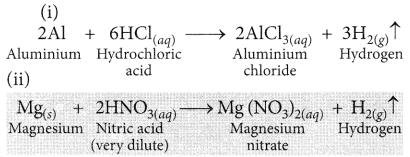
Question 5.
Compare in tabular form the reactivities of the following metals with cold and hot water: (2020)
(a) Sodium
(b) Calcium
(c) Magnesium
Answer: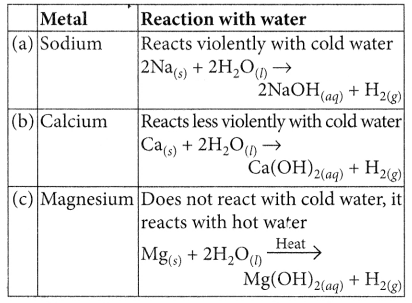
Question 6.
Give reason for the following:
(i) Hydrogen gas is not evolved when most of the metals react with nitric acid.
(ii) Zinc oxide is considered as an amphoteric oxide.
(iii) Metals conduct electricity. (Board Term I, 2016)
Answer:
(i) Hydrogen gas is not evolved when most metals react with nitric acid. It is because HNO3 is a strong oxidising agent. It oxidises the H2 produced to water and itself gets reduced to any of the nitrogen oxides (N2O, NO, NO2).
(ii) ZnO reacts both with acids as well as bases to form salt and water. Thus, ZnO is an amphoteric oxide.
(iii) Metals conduct electricity due to the flow of free electrons present in them.
Question 7.
(a) Why does calcium start floating when it reacts with water? Write the balanced chemical equation of the reaction.
(b) Name two metals which do not react with water. (Board Term I, 2015)
Answer:
(a) Calcium reacts with cold water to form calcium hydroxide and hydrogen gas.![]()
The bubbles of hydrogen gas produced stick to the surface of calcium and hence, it starts floating on the surface of water.
(b) Gold and silver do not react with water.
Question 8.
State what would happen if:
(i) some zinc pieces are placed in blue copper sulphate solution.
(ii) some’copper pieces are placed in green ferrous sulphate solution.
(iii) an iron nail is dipped in a solution of copper sulphate for some time. (Board Term I, 2014)
Answer:
(i) Refer to answer 1.
(ii) Cu + FeSO4 No Reaction
Cu is less reactive than Fe, thus, it cannot displace Fe from FeSO4 solution.
(iii) When an iron nail is dipped in copper sulphate solution, then the blue colour of copper sulphate fades gradually and a reddish brown coating is formed on the iron nail.
As iron is more reactive than copper, it displaces copper from copper sulphate solution.
Question 9.
Give reason:
(a) Aluminium is a reactive metal but is still used for packing food articles.
(b) Calcium starts floating when water is added to it. (Board Term I, 2014)
Answer:
(a) Aluminium is a strong and cheap metal. It is also a good conductor of heat. But it is highly reactive. When it is exposed to moist air, its surface is covered with a thin impervious layer of aluminium oxide (Al2O3). This layer does not allow moist air to come in contact with the fresh metal and hence, protects the metal underneath from further damage or corrosion. Thus, after the formation of this protective layer of Al2O3, aluminium becomes resistant to corrosion. It is because of this reason that although aluminium is a highly reactive metal, it is still used in food packaging.
(b) Refer to answer 7(a).
Question 10.
(a) Complete and balance the following chemical equations:
(i) Al2O3 + HCl →
(ii) K2O + H2O →
(iii) Fe + H2O →
(b) An element ‘X’ displaces iron from the aqueous solution of iron sulphate. List your observations if the element ‘X’ is treated with the aqueous solutions of copper sulphate, zinc sulphate and silver nitrate. Based on the observations arrange X, Zn, Cu and Ag in increasing order of their reactivities. (2020)
Answer:
(a) (i) Al2O3 + 6HCl → 2AlCl3 + 3H2O
(ii) K2O + H2O → 2KOH
(iii) 3Fe + 4H2O → Fe3O4 + 4H2
(b) As X displaces iron from its salt solution hence X is more reactive than iron. It will also displace copper from copper sulphate and silver from silver nitrate as both are less reactive than iron. As zinc is more reactive than iron hence, X can be more or less reactive than zinc. Then the order of their reactivities can be
Ag < Cu < Fe < Zn < X or Ag < Cu < Fe < X < Zn.
Question 11.
A metal ‘X’ combines with a non-metal ‘Y’ by the transfer of electrons to form a compound Z.
(i) State the type of bond in compound Z.
(ii) What can you say about the melting point and boiling point of compound Z?
(iii) Will this compound dissolve in kerosene or petrol?
(iv) Will this compound be a good conductor of electricity? (Board Term I, 2017)
Answer:
X being a metal loses electrons and Y being a non-metal gains electrons to form Z.
(i) The chemical bond formed by the transfer of electrons from one atom to another is known as an ionic bond. Hence, Z is an ionic compound.
(ii) Compound Z is an ionic compound thus, it has high melting and boiling points.
(iii) Ionic compounds are insoluble in non-polar solvents such as kerosene or petrol.
(iv) As Z is an ionic compound, it does not conduct electricity in the solid state because movement of ions in the solid is not possible due to their rigid structure. But it conducts electricity in the molten state or in aqueous solution due to the movement of ions freely.
Question 12.
(i) By the transfer of electrons, illustrate the formation of bond in magnesium chloride and identify the ions present in this compound.
(ii) Ionic compounds are solids. Give reasons.
(iii) With the help of a labelled diagram show the experimental set up of action of steam on a metal. (2020)
Answer:
(ii) Ionic compounds are solids because the particles which make up ionic compounds are held together by strong electrostatic bonds.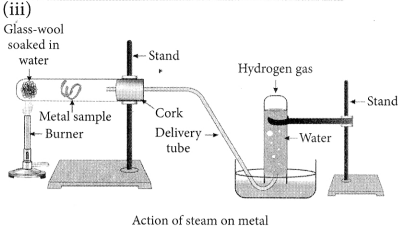
Question 13.
(a) (i) Write two properties of gold which make it the most suitable metal for ornaments.
(ii) Name two metals which are the best conductors of heat.
(iii) Name two metals which melt when you keep them on your palm.
(b) Explain the formation of ionic compound CaO with electron-dot structure. Atomic numbers of calcium and oxygen are 20 and 8 respectively. (2020)
Answer:
(a) (i) The malleability and ductility properties of gold make it suitable for ornaments.
(ii) Silver and gold.
(iii) Gallium and caesium have so low melting points that they melt even on keeping them on palm.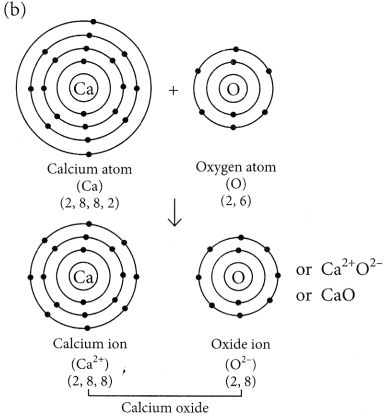
Question 14.
(i) Write down the electronic configuration
of magnesium and oxygen.
(ii) Give two general properties of the compound formed by combination of magnesium and oxygen.
(iii) Show the formation of this compound by the transfer of electrons. (Board Term 1,2014)
Answer:
(i) Atomic number of magnesium (Mg) = 12
∴ Its electronic configuration = 2, 8, 2
Atomic number of oxygen = 8
Electronic configuration of oxygen = 2, 6
(ii) Magnesium (Mg) reacts with oxygen (O2) to form magnesium oxide (MgO).
2Mg + O2 → 2MgO
Properties of MgO are :
(a) It involves ionic bonding.
(b) It has high melting point due to strong electrostatic forces of attraction between Mg2+ and O2- ions.
(iii) In the formation of magnesium oxide, two electrons are transferred from magnesium atom to oxygen atom as represented :
Question 15.
An ore on treatment with dilute hydrochloric acid produces brisk effervescence. Name the type of ore with one example. What steps will be required to obtain metal from the enriched ore? Also write the chemical equations for the reactions involved in the process. (AI 2019)
Answer:
The ore on treatment with dilute hydrochloric acid produces brisk effervescence hence, it must be a carbonate ore. Calamine (ZnCO3) is an important carbonate ore of zinc.
Steps required to obtain metal from the enriched carbonate Are:
(a) Conversion of the carbonate ore into metal oxide : This is done by calcination (for carbonate ores).
Calcination is the process of heating the ore strongly in the absence or limited supply of air. The zinc carbonate on heating decomposes to form zinc oxide as shown :
(b) Reduction of the metal oxide to metal : As zinc is moderately reactive, zinc oxide cannot be reduced by heating alone. Hence, it is reduced to zinc by using a reducing agent such as carbon.
The reduction of metal oxides by heating with coke is called smelting.
Question 16.
(i) Carbonate of metal ‘2T is abundant in earth crust and its hydroxide is used in ‘white washing’. Identify metal ‘XI
(ii) How will you convert this carbonate into its oxide? Name the process and write its equation. (Board Term I, 2014)
Answer:
(i) Calcium carbonate is abundant in earth’s crust and calcium hydroxide is used in white washing. Hence, metal X is calcium (Ca).
(ii) CaCO3 is strongly heated in the absence of air to get the metal oxide. This process is called calcination.
Question 17.
Zinc is a metal found in the middle of the activity series of metals. In nature, it is found as a carbonate ore, ZnCO3. Mention the steps carried out for its extraction from the ore. Support with equations. (Board Term 1,2013)
Answer:
Refer to answer 15.
Question 18.
Carbon cannot reduce the oxides of sodium, magnesium and aluminium to their respective metals. Why? Where are these metals placed in the reactivity series? How are these metals obtained form their ores? Take an example to explain the process of extraction along with chemical equations. (2020)
Answer:
Sodium, magnesium and aluminium have higher affinity towards oxygen than that of carbon because these are highly reactive metals. Hence, carbon cannot reduce the oxides of sodium, magnesium and aluminium to their respective metals. These metals are placed at the top of the reactivity series. The highly reactive metals like Na, Mg, Al, etc. are extracted by electrolytic reduction of their molten chlorides or oxides. Electrolytic reduction is brought about by passing electric current through the molten state. Metal gets deposited at the cathode.
NaCl ⇌ Na+ + Cl–
At cathode : Na+ + e– → Na
At anode : 2Cl– → Cl2 + 2e–
Question 19.
Write balanced chemical equations to explain what happens, when
(i) Mercuric oxide is heated.
(ii) Mixture of cuprous oxide and cuprous sulphide is heated.
(iii) Aluminium is reacted with manganese dioxide.
(iv) Ferric oxide is reduced with aluminium.
(v) Zinc carbonate undergoes calcination. (2020)
Answer:
(i) On heating, mercuric oxide decomposes to give mercury .and oxygen.![]()
(ii) On heating mixture of cuprous oxide and cuprous sulphide, copper and sulphur dioxide are produced.![]()
(iii) When aluminium is heated with manganese dioxide, manganese and aluminium oxide are formed.![]()
(iv) Ferric oxide reacts with aluminium to produce aluminium oxide and iron.![]()
(v) On calcination, zinc carbonate produces zinc oxide and carbon dioxide.![]()
Question 20.
(a) List in tabular form three chemical properties on the basis of which we can differentiate between a metal and a non¬metal.
(b) Give reasons for the following :
(i) Most metals conduct electricity well.
(ii) The reaction of iron (III) oxide [Fe2O3] with heated aluminium is used to join cracked machine parts. (Delhi 2019)
Answer:
| s.no. | Chemical property | Metals | Non-metals |
| 1. | Nature of oxides | Metals generally form basic oxides. | Non-metals generally form acidic oxides. |
| 2. | Reaction with water | Metals which lie above hydrogen in the reactivity series displace hydrogen from water. | Non-metals (except F) do not react with water. |
| 3. | Oxidising or reducing character. | Metals generally behave as reducing agents. | Non-metals generally behave as oxidising agents. |
(b) (i) Refer to answer 6 (iii).
(ii) The reaction of iron (III) oxide, Fe2O3 with aluminium is highly exothermic and the iron produced melts. This molten iron is used to join cracked iron parts of machines and railway tracks.
Question 21.
(a) Write the steps involved in the extraction of pure metals in the middle of the activity series from their carbonate ores.
(b) How is copper extracted from its sulphide ore? Explain the various steps supported by chemical equations. Draw labelled diagram for the electrolytic refining of copper. (2018)
Answer:
(a) Extraction of metals of medium reactivity:
The metals in the middle of the reactivity series are zinc, iron, lead, etc. The carbonate ores first need to get converted to oxides as it is easier to get metal from their oxides.
Refer to answer 15.
(b) Copper glance (Cu2S) when heated in air gets partially oxidised to copper oxide which further reacts with the remaining copper glance to give copper metal.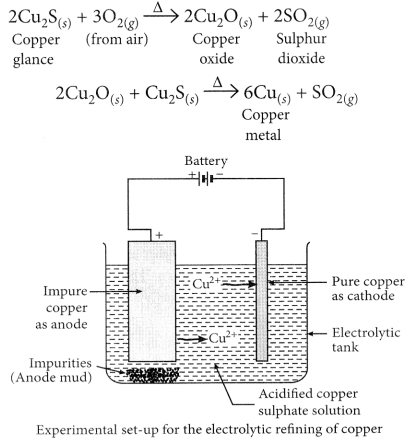
Question 22.
Draw a schematic diagram of the various steps involved in the extraction of metals from ores for metals of medium reactivity and for metals of low reactivity. (Board Term I, 2018)
Answer:
Various steps involved in the extraction of a metal from its ore followed by refining of the metal is called ‘metallurgy’. The steps involved are summarised as follows :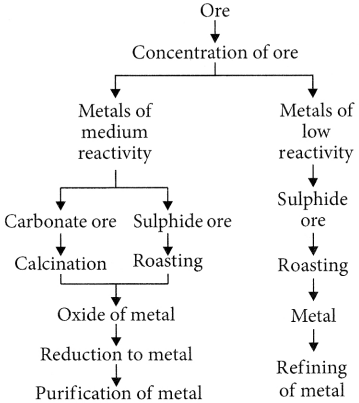
Question 23.
(a) Describe an activity to show that metals are good conductors of electricity.
(b) Account for the following :
(i) Hydrogen gas is not evolved when a metal reacts with nitric acid.
(ii) For storing sodium metal, it is kept immersed in kerosene.
(iii) The reaction of iron (III) oxide with aluminium is used to join cracked iron parts of machines. (Board Term I, 2016)
Answer:
(a) Activity : (i) Set up an electric circuit as shown in the figure.
(ii) Place the metal to be tested (Cu, Al, Ag, Fe, etc.) in the circuit, between the terminal A and B.
(iii) Switch on the battery.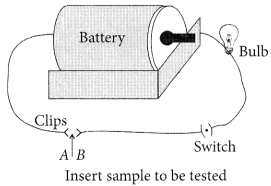
Observations : Bulb begins to glow.
Conclusion : This indicates that the current is flowing through the metal wire. Hence, metals are good conductors of electricity.
(b) (i) Refer to answer 6(i).
(ii) Sodium reacts vigorously with air and catches fire. Also, sodium reacts with water and the hydrogen gas is evolved which catches fire. Therefore, sodium is kept under kerosene.
(iii) Refer to answer 20(b) (ii).
Question 24.
How is copper obtained from its ore (Cu2S)?
Write only the chemical equations. How is copper thus obtained refined? Name and explain the process along with a labelled diagram. (Board Term I, 2015)
Answer:
Refer to answer 21(b).
Copper obtained is refined by electrolytic refining.
Electrolytic refining of crude copper :
Thick block of impure metal acts as anode and a thin strip of pure copper metal acts as cathode. The electrolyse used is aqueous solution of copper sulphate containing a small amount of sulphuric acid. On passing electric current through the electrolyte, the metal from the anode dissolves into the electrolyte. An equivalent amount of copper metal from copper sulphate solution gets deposited on cathode.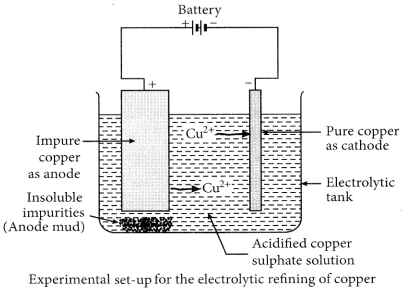
Question 25.
(a) Copper produced by heating the ore in air is not very pure. Describe the method used for refining impure copper. Draw labelled diagram of the process.
(b) Write chemical equations for the reactions taking place when :
(i) zinc sulphide is heated in air.
(ii) zinc carbonate is calcined. (Board Term I, 2014)
Answer:
Refer to answer 24.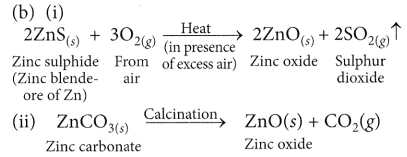
Question 26.
Assertion (A) : The metals and alloys are good conductors of electricity.
Reason (R) : Bronze is an alloy of copper and tin and it is not a good conductor of electricity.
(a) Both (A) and (R) are true and (R) is the correct explanation of the assertion (A).
(b) Both (A) and (R) are true, but (R) is not the correct explanation of the assertion (A).
(c) (A) is true, but (R) is false.
(d) (A) is false, but (R) is true.
Answer:
(c) : Metals and alloys have free electrons in them which can move freely inside them, so they conduct electricity very easily. Bronze is an alloy of copper and tin and it is a very good conductor of electricity.
Question 27.
Name first discovered alloy. Give its composition also. (Board Term I, 2014)
Answer:
Bronze is the first discovered alloy. Its composition is copper (90%) and tin (10%).
Question 28.
List three differentiating features between the processes of galvanisation and alloying.
Answer:
| Galvanisation | Alloying |
| 1. It is the process of applying a protective zinc coating to steel or iron, to prevent rusting. | 1. It is the process of combining two or more metals or a metal and a non-mental. |
| 2. It is done through electrolysis. | 2. It is done by heating the primary metal and adding other elements in definite proportions and then cooling it down to room temperature. |
| 3. The properties of inner metal are not changed. | 3. The properties like strength, conductivity etc. are changed. |
Question 29.
Describe an activity to find out the conditions under which iron rusts. (Board Term I, 2017)
Answer:
Activity:
(i) Take three test tubes and put clean nails in each of the three tubes. Label them as A, B and C.
(ii) Pour some water in test tube A and cork it.
(iii) In tube B, pour some boiled distilled water along with some turpentine oil and cork it.
(iv) In test tube C, add some anhydrous calcium chloride and cork it.
(v) Look these test tubes properly and keep them undisturbed for a few days.
Observation : Only in test tube A, iron nails get rusted since the nails in this test tube are exposed to both air and water.
Conclusion : Both air and water are required for rusting of iron.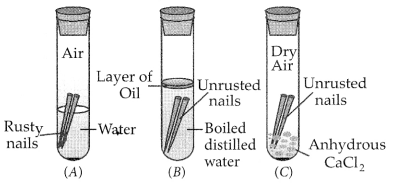
Question 30.
Why some metal surfaces acquire a dull appearance when they are exposed to moist air? Write colour acquired by the surfaces of copper and silver in such situation and also write the chemical names of the substances due to which it happens. (Board Term I, 2016)
Answer:
When a metal has been kept exposed to air for a long time, then it gets a dull appearance. The metals lose their shine or brightness due to the formation of a thin layer of oxide, carbonate or sulphide on their surface and thus, the metal surface gets corroded. The surface of copper gets coated with a green layer in moist air due to the formation of basic copper carbonate, silver articles acquire a blackish tinge due to the formation of silver sulphide.
Question 31.
(a) Name the following :
(i) Metal that can be cut by knife
(ii) Lustrous non-metal
(iii) Metal that exists in liquid state at room temperature
(iv) Most malleable and ductile metal
(v) Metal that is best conductor of electricity
(vi) Non-metal that can exist in different forms
(b) How are alloys better than metals? Give composition of solder and amalgam.
Answer:
(a) (i) Sodium
(ii) Iodine
(iii) Mercury
(iv) Gold
(v) Silver
(vi) Carbon
(b) Alloys are stronger than the metals from which they are made, more resistant to corrosion, have lower melting point, have lower electrical conductivity. Solder is an alloy of lead and tin. An amalgam is an alloy of mercury with another metal.
Question 32.
(a) Define corrosion.
(b) What is corrosion of iron called?
(c) How will you recognise the corrosion of silver?
(d) Why corrosion of iron is a serious problem?
(e) How can we prevent corrosion of iron? (Board Term I, 2017)
Answer:
(a) The process of slowly eating up of metals due to their conversion into oxides, carbonates, sulphides, etc., by the action of atmospheric gases and moisture is called corrosion.
(b) The corrosion of iron is called rusting.
(c) Silver articles become black after sometime when exposed to air. This is due to formation of a coating of black silver sulphide (Ag2S) on its surface by the action of H2S gas present in the air.
(d) Corrosion of iron is a serious problem. Every year large amount of money is spent to replace damaged iron articles. Corrosion causes damage to car bodies, bridges and iron railings, ships and to all objects made of metals specially those of iron.
(e) Corrosion of iron is prevented by coating it with a layer of oil. The reason being that the layer of oil does not allow air and water to react the surface of iron. Corrosion of iron can also be prevented by painting, greasing, galvanising, anodising, electroplating or making alloys.
Question 33.
Give reason for the following :
(a) Ionic compounds have higher melting point and higher boiling point.
(b) Sodium is kept immersed in kerosene.
(c) Reaction of calcium with water is less violent.
(d) Silver articles become black after some time when exposed to air.
(e) Prior to reduction the metal sulphides and carbonates must be converted into metal oxides for extracting metals. (Board Term I, 2015)
Answer:
(a) Due to strong forces of attraction, the ions are bound to each other very firmly. As a result, the electrovalent or ionic solids have high melting and boiling points.
(b) Refer to answer 23(b) (ii).
(c) Calcium reacts with cold water but the reaction is less violent. The heat evolved is not sufficient for the hydrogen to catch fire.![]()
(d) Refer to answer 32(c).
(e) The reduction of metal oxides to metal is easier than the reduction of metal sulphides and metal carbonates. Hence, these are first reduced to their corresponding metal oxides.
Question 34.
(a) Metals like iron, silver and copper get corroded on exposure to air. Write the chemical name of the substance deposited on their surface respectively with it’s colour, in each case.
(b) List four ways by which rusting can be prevented. (Board Term I, 2013)
Answer:
(a) Iron gets corroded and forms ferric oxide which is rust, it is reddish brown in colour. For silver and copper, refer to answer 30.
(b) The various methods used for preventing the rusting of iron are given below:
(i) By applying paint : Materials like railings, iron gates, iron bridges, bodies of cars, buses and trucks, etc. are all painted to protect them from rusting. Painting the metal surface does not allow them to come in contact with the moist air and thus, prevents rusting.
(ii) Greasing and oiling : When some grease or oil is applied on the surface of an iron object, then moisture and air cannot come in contact with it and hence, rusting is prevented.
(iii) Galvanization : It is a method of protecting iron from rusting by coating them with a thin layer of zinc. The iron coated with zinc is called galvanized iron.
(iv) Electroplating : It is another technique used to prevent articles from rusting. In this process, metals like tin, nickel and chromium which do not corrode are electroplated on iron.
Short Answer Type Questions[l] [2 Marks]-Year 2015
35.Write one example of each of
(i) a metal which is so soft that, it can be cut with knife and a non-metal which is the hardest sustance.
(ii) a metal and a non-metal which exist as liquid at room temperature.
Answer.
(i) Sodium, carbon (diamond).
(ii)Mercury is liquid metal, bromine is liquid non-metal.
36.Mention the names of the metals for the following:
(i) Two metals which are alloyed with iron to make stainless steel.
(ii) Two metals which are used to make jewellary.
Answer.
(i) Nickel and chromium.
(ii) Gold and platinum.
Short Answer Type Question[l] [2 Marks] -Year 2013
37.Give reason for the following:
(a) School bells are made up of metals.
(b) Electric wires are made up of copper.
Answer.
(a) It is because metals are sonorous, i.e. they produce sound when struk with a hard substance.
(b) It-is because copper is good conductor of electricity.
Short Answer Type Question[ll] [3 Marks] -Year 2013
38. Suggest a method of reduction for the following metals during their metallurgical processes:
(i) metal ‘A’ which is one of the last, second or third position in the reactivity.
(ii) metal ‘B’ which gives vigorous reaction even with water and air.
(iii) metal ‘C’ which is kept in the middle df activity series.
Answer.
(i) ‘A’ can be obtained by chemical reduction using carbon or carbon monoxide as reducing agent.
(ii) ‘B’ can be obtained by electrolytic reduction.
(iii) ‘C’ can be reduced by reducing agent like ‘Al’.
Very Short Answer Type Question [1 Mark] -Year 2012
39.A green layer is gradually formed on a copper plate left exposed to air for a week in a bathroom. What could this green substance be?
Answer. It is due to the formation of basic copper carbonate [CuC03.Cu(0H)2].
Short Answer Type Questions[l] [2 Marks] -Year 2012
40.Name the following:
(a) A metal, which is preserved in kerosene.
(b) A lustrous coloured non-metal.
(c) A metal, which can melt while kept on palm.
(d) A metal, which is a poor conductor of heat.
Answer.
(a) Sodium is preserved in kerosene.
(b) Iodine is lustrous coloured non-metal.
(c) Gallium. ‘
(d) Lead.
41. Give reason for the following:
(a) Aluminium oxide is considered as an amphoteric oxide.
(b) Ionic compounds conduct electricity in molten state.
Answer.
(a) It is because it reacts with acids as well as bases to produce salts and water.’Al’ is less electropositive metal. So, it forms amphoteric oxide which can react with acid as well as base.
(b) Ionic compounds can conduct electricity in molten state because ions ’ become free to move in molten state.
Short Answer Type Questions[ll] [3 Marks] -Year 2012
42. A metal ‘X’ acquires a green colour coating on its surface on exposure to air.
(i) Identify the metal ‘X’ and name the process responsible for this change.
(ii)Name and write chemical formula of the green coating formed on the metal.
(iii) List two important methods to prevent the process.
Answer.
(i) Metal is copper. The process is corrosion.
(ii)Basic copper carbonate [CuCO3.Cu(0H)2].
(iii)
• It should be coated with tin
• It should be mixed with other metals to form alloys.
43.What are amphoteric oxides? Choose the amphoteric oxides from amongst the following oxides:
Na2O, ZnO, Al2O3, CO2, H2O
Answer.Those oxides which reacts with acids as well as bases to produce salts and water are called amphoteric oxides, e.g. Na2O, ZnO, are amphoteric oxides among given oxides.
44.Define the terms:
(i) mineral
(ii) ore, and
(iii) gangue.
Answer.
(i) Mineral: It is a naturally occurring substance from which metal may or may not be extracted profitably or economically, e.g. A1 cannot be extracted profitably from mica.
(ii)Ore: It is a rocky material which contains sufficient quantity of mineral so that metal can be extracted profitably, e.g. zinc blende is an ore of zinc from which zinc can be extracted profitably.
(iii) Gangue: It is a rocky material which is present along with the mineral in the ore, e.g. FeO is gangue in extraction of copper.
Long Answer Type Questions [5 Marks] -Year 2012
45. (a) Write the chemical name of the coating that forms on silver and copper articles when these are left exposed to moist air.
(b) Explain what is galvanisation. What purpose is served by it?
(c) Define an alloy. How are alloys prepared? How do the properties of iron change when:
(i) small quantity of carbon,
(ii) nickel and chromium are mixed with it.
Answer.
(a) Ag2S (silver sulphide) is formed on silver, basic copper carbonate CuCO3. CU(OH)2 is formed on copper.
(b) The process of coating zinc over iron is called galvanisation. It is used to prevent rusting of iron.
(c) Alloy is a homogeneous mixture of two or more metals. One of them can be non-metal. Alloys are prepared by melting two or more metals together.
(?) Iron does not rust on adding small,quantity of carbon.
(ii) When we form alloy of iron with nickel and chromium, we get stainless steel which is malleable and does not get rusted.
46.(a) Carbon cannot be used as reducing agent to obtain Mg from MgO. Why?
(b) How is sodium obtained from molten sodium chloride? Give equation of the reactions.
(c) How is copper obtained from its sulphide ore? Give equations of the reactions.
Answer.
(a) It is because ‘Mg’ is stronger reducing agent than carbon.
(b) Sodium is obtained from molten NaCl by electrolysis.
Blister Copper is purified by electrolytic refining.
47.Give reasons for the following:
(i) Silver and copper lose their shine when they are exposed to air. Name the substance formed on their surface in each case.
(ii) Tarnished copper vessels are cleaned with tamarind juice.
(iii) Aluminium is more reactive than iron yet there is less corrosion of aluminium as compared to iron when both are exposed to air.
Answer.
(i) These metals get corroded. Silver forms black Ag2S (silver sulphide) and copper form greenish layer of basic copper carbonate CuCO3. CU(OH)2 .
(ii) Tamarind contains acid which reacts with basic copper carbonate and product gets dissolved and removed from copper vessel.
(in) Aluminium forms oxide layer on its surface which does not further react with air.
48. What are alloys? How are they made? Name the constituents and uses of brass, bronze and solder.
Answer. Alloys are homogeneous mixtures of two or more metals. One of them can be a non-metal also. They are made by melting a metal which is in large amount first and then adding the other metal. ,
Brass contains copper and zinc. It is used for making decorative articles. Bronze contains copper and tin. It is used for making statues and medals. Solder contains lead and tin. It is used for soldering purposes.
Very Short Answer Type Questions [1 Mark] -Year 2011
49. A non-metal X exists in two different forms Y and Z. Y is the hardest natural substance, whereas Z is a good conductor of electricity. Identify X, Y and Z.
Answer. ‘X’ is carbon, ‘Y’ is diamond as it is the hardest natural substance and ‘Z’ is graphite as it is good conductor of electricity.
50. Why does calcium float in water?
Answer. It is because hydrogen gas is formed which sticks to surface of calcium, therefore it floats. –
51.Name a non-metal which is lustrous and a metal which is non-lustrous. Iodine is a non-metal which is lustrous,
Answer.lead is a non-lustrous metal.
52.Which gas is liberated when a metal reacts with an acid? How will you test the presence of this gas?
Answer. Hydrogen gas is formed. Bring a burning matchstick near to it, H2 will burn explosively with ‘pop’ sound.
53.Name the metal which reacts with a very dilute HNOs to evolve hydrogen gas.
Answer. Magnesium
54.Name two metals which are found in nature in the free state.
Answer.(i) Gold (ii) Silver
Answer Type Questions[l] [2 Marks] -Year 2011
55.The way, metals like sodium, magnesium and iron react with air and water is an indication of their relative positions in the ‘reactivity series’. Is this statement true ? Justify your answer with examples.
Answer.Yes, sodium reacts explosively even with cold water, it is most reactive. Magnesium reacts with hot water, it is less reactive than Na. Iron reacts only with steam which shows it is least reactive among the three.
56. X + YSO4——-> XSO4+ Y
Y + XSO4 ——–> No reaction
Out of the two elements, ‘X’ and ‘Y’, which is more reactive and why?
Answer. ‘X’ is more reactive than ‘Y’ because it displaces ‘Y’ from its salt solution.
57.What is an alloy? State the constituents of solder. Which property of solder makes it suitable for welding electrical wires?
Answer. Alloy is a homogeneous mixture of two or more metals. One of them can be a non-metal also. Solder consists of lead and tin. It has low melting point which makes it suitable for welding electrical wires.
58. Write chemical equations that shows aluminium oxide reacts with acid as well as base.
Answer.
Long Answer Type Questions [5 Marks] -Year 2011
59.(a) How can the metals at the top of the reactivity series be extracted from their ores? Explain with an example.
(b) Name any one alloy made from
(i) a metal and a non-metal, and
(ii) two metals.
Answer.
(a) These metals are extracted by electrolytic reduction, e.g. aluminium is obtained from bauxite by electrolytic reduction.
(b) (i) Steel is made up of iron and carbon.
(ii) Brass is made up of copper and zinc.
Very Short Answer Type Questions [1 Mark] -Year 2010
60.What is the valency of silicon with atomic number 14?
Answer. Its valency is equal to 4.
61.What is the valency of phosphorus with atomic number 15?
Answer. Phosphorus has valency 3.
62.What is the valency of an element with atomic number 35?
Answer. Its valency is 1.
Short Answer Type Question[I] [2 Marks] -Year 2010
63.Elements magnesium and oxygen respectively belong to group 2 and group 16 of the Modern Periodic Table. If the atomic numbers of magnesium and oxygen are 12 and 8 respectively, draw their electronic configurations and show the process of formation of their compound by transfer of electrons.
Answer.(Mg)=2,8,2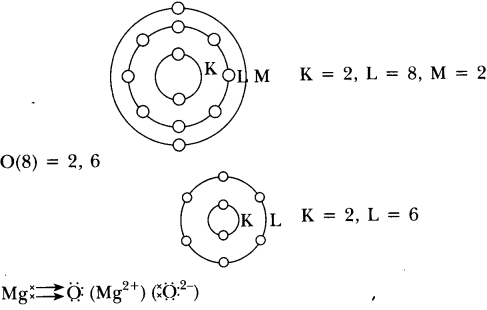
Very Short Answer Type Question [1 Mark] -Year 2009
64. Arrange the following metals in the decreasing order of reactivity: Na, K, Cu, Ag.
Answer. K > Na > Cu > Ag
Short Answer Type Questions[ll] [3 Marks] -Year 2009
65. Give reasons for the following observations:
(i) Ionic compounds in general have high melting and boiling points.
(ii) Highly reactive metals cannot be obtained from their oxides by heating
them with carbon.
(iii) Copper vessels get a green coat when left exposed to air in the rainy season.
Answer. (i) Ionic compounds have high melting and boiling points due to strong force of attraction between oppositely charged ions.
(ii) It is because these metals themselves are strong reducing agents. Therefore, cannot be reduced by reducing agent like carbon.
(iii) Copper vessels react with CO2, O2 and moisture to form green-coloured basic copper carbonate
[CuCO3.Cu(OH)2].
66. State reasons for the following observations:
(i) The shining surface of some metals becomes dull when exposed to air for a long time.
(ii) Zinc fails to evolve hydrogen gas on reacting with dilute nitric acid.
(iii) Metal sulphides occur mainly in rocks but metal halides occur mostly in sea and lake waters.
Answer.
(i) It is because metal reacts with substances present in atmosphere to form surface compounds which make it dull.
(ii) It is because dil. HNOs is an oxidising agent therefore zinc gives NO and notH2 with dil. HNOs.
(iii) It is because sea water contains sodium chloride due to which metal halides are formed, whereas sulphur is found below rocks. Therefore, metal – sulphides are formed in rocks.
67. State reasons for the following:
(i) Electric wires are covered with rubber like material.
(ii)From dilute hydrochloric acid, zinc can liberate hydrogen gas but copper cannot.
(iii) Sulphide ore of a metal is first converted to its oxide to extract the metal from it.
Answer.
(i) It is because rubber is an insulator and does not allow current to flow through it.
(ii) Zinc is more reactive than hydrogen. Therefore, it can displace hydrogen from dilute HCl whereas copper cannot, because it is less reactive than hydrogen. ,
(iii) It is because it is easier to reduce oxide ore as compared to sulphide ore.
Long Answer Type Questions [5 Marks] -Year 2009
68.(a) What is meant by corrosion? Name any two methods used for the prevention
of corrosion.
(b) Suppose you have to extract metal M from its enriched sulphide ore. If M is in the middle of the reactivity series, write various steps used in extracting this metal.
Answer. (a) Corrosion is a process in which metal reacts with substances present in the environment to form surface compounds.
Prevention:
(i) Galvanisation is a process to prevent corrosion of iron.
(ii)Electroplating is also used to prevent corrosion.
(b)(i) Concentration of ores: Sulphide ore will be concentrated by froth- floatation process. Sulphide ore will be collected in froth whereas gangue will be left behind.
(ii) Roasslng: Sulphide ore is heated strongly in the presence of O2 to form metal oxide and sulphur dioxide.
2MS + 3O2 ————- ► 2MO + 2SO2
(iii) Reduction: MO reacts with carbon (acts as reducing agent) to form metal and CO.
MO + C —-> M + CO
(iv) Electrolytic refining: Impure metal ‘M’ is purified by electrolytic refining. Impure metal is taken as anode, pure metal is taken as cathode, soluble salt of metal is taken as electrolyte. Impure metal forms metal ions which gain electrons and form pure metal at cathode.